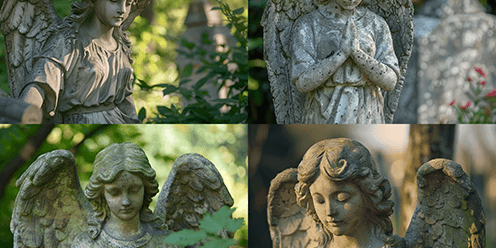As a symbol of permanent remembrance of the deceased, the decorative style of tombstones not only reflects local cultural traditions and religious beliefs, but also carries the remembrance and respect for the deceased. In this paper, we will explore the differences and characteristics of tombstone decoration styles from the cultural backgrounds of China, the United States, Western Europe (France, Belgium, Portugal, the United Kingdom, etc.), Australia, Russia, Japan, and the Middle East.
Chinese
In China, the style of tombstone decoration emphasizes more on tradition and ancestor worship. Common decorative elements for headstones include traditional patterns, such as dragon and phoenix motifs, lotus flowers, and cloud patterns, as a sign of respect for the deceased and a symbol of family honor. In addition, for those with religious beliefs, Taoist and Buddhist symbols and scriptures are often carved on tombstones, signifying peace and eternity for the soul. Family coats of arms and images or names of ancestors are also commonly used in headstone decoration, reflecting the family’s emphasis on tradition and lineage.
Characteristics of the decorative style: Tradition, Ancestor worship, Religious beliefs (Taoism and Buddhism), Family coat of arms

Flower and bird carving

Dragon carving

Lion statue

Chinese style tombstone
United States
In the United States, tombstone decoration styles are diverse, mainly reflecting personalization and religious freedom. In addition to the common Christian crosses and angel statues, personalized decorations are becoming increasingly popular, such as carvings of the deceased’s favorite animals, musical symbols or sports patterns. Also common on headstones are the deceased’s favourite memorial objects, such as balls, tools or books, which represent hobbies and personalized ways of remembrance during life.
Characteristics of decorative styles: Personalization, Religious symbols, Memorial objects

Upright Flat Slant Headstone
Western Europe (France, Belgium, Portugal, England, etc.)
In Western Europe, the decorative style of tombstones emphasizes the application of sculptural art and heraldry. Complex and exquisite carving patterns, such as flowers, angels, portraits, etc., are common on marble tombstones, and these works of art show the high skill of the carver and the social status of the deceased. Heraldic symbols on headstones carry on the honor and historical significance of the family, and the family crests and heraldic patterns express respect and heritage for the deceased’s family.
Characteristics of decorative styles: Carving art, Heraldry, Historical significance
Australia
In Australia, the decorative style of headstones emphasizes naturalism and minimalist aesthetics. Common decorations include natural stone headstones, such as granite and sandstone sculptures in their natural form. These figurative decorations reflect respect for the natural environment and wishes for the eternal rest of the deceased. Minimalist carvings and natural texture patterns give headstones a more harmonious and natural look.
Decorative style characteristics: Naturalism, Minimalist aesthetics

Japan
In Japan, the decorative style of headstones reflects minimalist aesthetics and wabi-sabi elements. Common decorations include simple tombstone designs that emphasize minimalist and fresh aesthetics. Common wabi-sabi elements such as cherry blossoms and maple leaves on headstones represent the changing seasons and the cycle of life. In addition, traditional Japanese stone lantern cages and garden-type cemetery designs are often seen in headstone decorations, reflecting the pursuit of natural harmony.
Characteristics of decorative style: Minimalist aesthetics, Japanese elements
Middle East
In the Middle East, the decorative style of tombstones is full of the characteristics of Islamic art and the application of geometric patterns. Typical Islamic decorations are commonly found on marble tombstones, such as carvings of Arabic letters and patterns of prayers, which are not only beautiful, but also have the symbolism of religious blessings. The use of geometric motifs makes the tombstones look more rigorous and symmetrical, reflecting the importance of math and geometry in Islamic culture.
Characteristics of decorative styles: Islamic decorations, Geometric patterns
 Ending
Ending
By exploring the decorative styles of tombstones in different cultures, we can see that the decoration of tombstones in each region not only reflects the personal and family values of the deceased, but also the unique charms of the local culture, religious beliefs, and artistic styles. Each decorative style carries deep cultural significance and becomes an important link between life and history.








